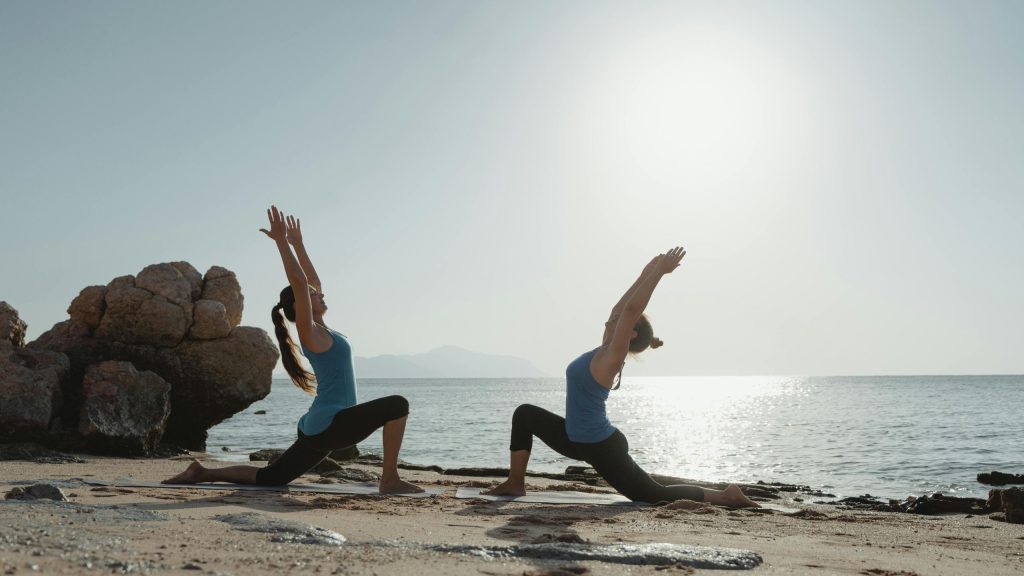Yoga, an ancient practice that originated in India, has become increasingly popular worldwide, including in the UK. As more people embrace yoga for its physical, mental, and spiritual benefits, the demand for qualified yoga teachers continues to rise.
If you have a passion for yoga and a desire to share its transformative power with others, becoming a yoga teacher in the UK can be a rewarding and fulfilling career path.
This comprehensive guide will outline the steps to become a certified yoga teacher, including the necessary training, qualifications, and professional development opportunities.
Develop a Solid Foundation in Yoga
Before embarking on the journey to become a yoga teacher, it’s essential to establish a strong personal practice and understanding of yoga.
This foundation will not only deepen your knowledge but also help you cultivate the confidence and credibility needed to guide others on the path of yoga.
Immerse Yourself in Yoga Practice
Regularly attend yoga classes and workshops to experience different styles, techniques, and teachings. Explore various forms of yoga, such as Hatha, Vinyasa, Ashtanga, Iyengar, or Yin Yoga, to find the ones that resonate most with you.
This immersion will help you develop your own personal practice and gain exposure to different teachers’ approaches.
Study Yoga Philosophy and History
Yoga is not just a physical practice; it’s a holistic system that encompasses philosophy, ethics, and spiritual principles. Read books, attend lectures, or join study groups to deepen your understanding of yoga’s rich history, philosophical concepts, and ethical guidelines.
This knowledge will enhance your ability to teach yoga beyond the physical postures and provide a more comprehensive experience for your future students.
Participate in Workshops and Retreats
Attend yoga workshops, retreats, or teacher training intensives to expand your knowledge and skills. These immersive experiences often offer opportunities to learn from renowned teachers, explore advanced techniques, and delve deeper into specific areas of yoga, such as meditation, anatomy, or therapy.
Choose a Teacher Training Program
The next step in becoming a yoga teacher is to enroll in a reputable teacher training program. These programs provide the foundational knowledge and practical skills necessary to teach yoga safely and effectively.
Research and Select a Registered Program
In the UK, yoga teacher training programs are not governed by a single accrediting body. However, it’s essential to choose a program that is recognized by organizations such as the British Wheel of Yoga (BWY) or Yoga Alliance Professionals (YAP). These organizations maintain standards and ensure that training programs meet specific curricular requirements.
Consider Program Duration and Focus
Yoga teacher training programs vary in duration, with the most common being 200-hour and 300-hour courses. The 200-hour program provides a solid foundation for teaching, while the 300-hour program offers a more comprehensive and in-depth study.
Additionally, some programs specialize in specific styles of yoga or areas of focus, such as prenatal yoga, yoga therapy, or advanced asana.
Evaluate Teaching Methodologies and Curriculum
When choosing a teacher training program, consider the teaching methodologies and curriculum. Look for programs that offer a balance of theoretical knowledge, practical teaching skills, and supervised teaching practice.
Ensure that the curriculum covers essential topics like anatomy, physiology, yoga philosophy, teaching methodology, sequencing, and classroom management.

Complete the Teacher Training Program
Once enrolled in a teacher training program, immerse yourself fully in the learning experience. Approach the training with an open mind, a willingness to learn, and a commitment to personal growth.
Engage in Theoretical and Practical Learning
Teacher training programs typically combine theoretical and practical components. Attend lectures and workshops to gain knowledge in areas such as yoga history, philosophy, anatomy, and teaching methodology.
Participate in practical sessions that focus on asana (posture) practice, sequencing, adjustments, and teaching techniques.
Develop Teaching Skills
During the training, you will have opportunities to practice teaching in front of your peers and receive feedback from experienced instructors.
This supervised teaching practice is crucial for developing your teaching skills, confidence, and ability to provide clear instructions, adjustments, and modifications.
Complete Required Assignments and Assessments
Most teacher training programs require students to complete assignments, written exams, and practical assessments to demonstrate their understanding and competence.
These assessments typically include teaching presentations, written essays, anatomy quizzes, and other evaluations of your knowledge and practical application.
Obtain Certification and Registration
Upon successful completion of a recognized yoga teacher training program, you will receive a certificate or diploma that qualifies you to teach yoga.
However, to practice as a professional yoga teacher in the UK, it’s important to obtain certification and registration with relevant professional organizations.
British Wheel of Yoga (BWY) Certification
The British Wheel of Yoga (BWY) is one of the leading organizations for yoga teachers in the UK. To become a BWY-certified teacher, you will need to complete a BWY-recognized teacher training program and meet additional requirements, such as completing a first aid course and attending regular CPD (Continuing Professional Development) events.
Yoga Alliance Professionals (YAP) Registration
Yoga Alliance Professionals (YAP) is another respected organization that provides registration for yoga teachers. To become a YAP-registered teacher, you will need to complete a YAP-recognized teacher training program and submit an application, along with supporting documentation and fees.
Gain Teaching Experience and Specialize
Once you have obtained your certification and registration, it’s essential to gain practical teaching experience and consider specializing in areas that align with your interests and strengths.
Teach and Build a Student Base
Begin teaching classes at local yoga studios, community centers, or gyms to gain experience and build a student base. Start small, and focus on providing high-quality instruction and cultivating a welcoming environment for your students.
As you gain more experience and confidence, you can expand your teaching opportunities and explore options like private sessions or corporate yoga classes.
Explore Specializations
As you develop your teaching skills, consider specializing in areas that particularly interest you. Some potential specializations include prenatal yoga, yoga for seniors, yoga therapy, children’s yoga, or advanced asana.
Pursuing additional training or certification in these areas can help you stand out as an expert in your chosen field and attract a specific clientele.
Pursue Continuing Professional Development (CPD)
To maintain your skills and knowledge as a yoga teacher, it’s crucial to engage in ongoing professional development. This will help you stay current with industry trends, deepen your understanding of yoga, and enhance your teaching abilities.
Attend Workshops and Trainings
Regularly attend workshops, intensives, and advanced trainings offered by experienced teachers, yoga schools, or professional organizations. These events provide opportunities to learn new techniques, explore specialized areas of yoga, and gain insights from respected practitioners.
Participate in Conferences and Retreats
Attend yoga conferences, festivals, and retreats to network with other teachers, learn from keynote speakers, and immerse yourself in a community of like-minded individuals. These events often offer a wide range of classes, lectures, and workshops, allowing you to expand your knowledge and gain inspiration from a diverse group of teachers.
Join Professional Organizations and Communities
Consider joining professional organizations like the British Wheel of Yoga (BWY) or Yoga Alliance Professionals (YAP). These organizations provide access to resources, events, and a network of fellow yoga teachers. They also offer opportunities for continuing education and professional development.
Engage in Self-Study and Mentorship
Continuously engage in self-study by reading books, watching instructional videos, and exploring new areas of yoga. Additionally, seek out mentorship from experienced teachers who can provide guidance, feedback, and support as you navigate your teaching journey.
FAQs
- How long does it take to become a yoga teacher in the UK?
Answer: The duration of training to become a yoga teacher in the UK can vary, but most recognized teacher training programs range from 200 to 300 hours.
A 200-hour program can typically be completed in 3-4 weeks of intensive training or over the course of several months on a part-time basis. A 300-hour program may take 4-6 weeks of full-time study or up to a year for part-time study.
- Do I need to have a certain level of yoga practice before starting teacher training?
Answer: While there is no specific requirement for years of practice before starting teacher training, most programs recommend that students have a consistent yoga practice for at least 1-2 years.
This ensures that you have a solid understanding of the fundamental postures, breathing techniques, and philosophical concepts, as well as a level of physical and mental readiness for the demands of teacher training.
- What are the job prospects for yoga teachers in the UK?
Answer: The job prospects for yoga teachers in the UK are generally favorable. As the popularity of yoga continues to grow, there is an increasing demand for qualified and experienced teachers.
Yoga teachers can find employment opportunities in yoga studios, health clubs, gyms, community centers, schools, and even corporate settings. Additionally, many yoga teachers choose to establish their own independent practices, offering private or group classes.
- How much can a yoga teacher earn in the UK?
Answer: The income potential for yoga teachers in the UK can vary widely depending on factors such as experience, location, teaching hours, and whether they work independently or for a studio or gym.
According to Glassdoor, the average base salary for a yoga teacher in the UK is around £25,000 per year. However, experienced teachers with a strong following and independent practices can potentially earn significantly more.
- Is it necessary to have a certification or registration to teach yoga in the UK?
Answer: While there is no legal requirement to have a specific certification or registration to teach yoga in the UK, it is highly recommended. Most reputable yoga studios and employers prefer to hire teachers who have completed recognized teacher training programs and hold certifications from organizations like the British Wheel of Yoga (BWY) or Yoga Alliance Professionals (YAP).
Certification and registration demonstrate your commitment to professional standards, ethics, and ongoing education.
Conclusion
Becoming a yoga teacher in the UK is a rewarding and fulfilling journey that combines personal growth, technical expertise, and a passion for sharing the transformative power of yoga with others.
By following the steps outlined in this guide, including developing a solid foundation in yoga practice, completing a recognized teacher training program, obtaining certification and registration, gaining practical teaching experience, specializing in areas of interest, and engaging in continuous professional development, you can embark on a meaningful career as a yoga teacher.
Remember that the path to becoming a successful yoga teacher is one of lifelong learning and self-discovery.

